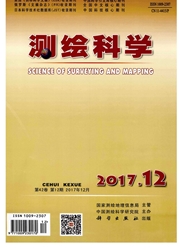

 中文摘要:
中文摘要:
以长江上游甘肃省尚沟流域为研究区,在遥感影像和GIS空间分析技术支撑下,根据USLE因子算法生成各因子栅格图,借助地图代数运算,估算了尚沟流域1998年和2004年的土壤侵蚀量,并对2004年土壤侵蚀与其环境背景因子进行叠加和空间统计分析。在此基础上,构建了与GIS软件平台集成的地理元胞自动机,模拟了该流域2004年、2010年和2020年土壤侵蚀空间演化情形。结果表明:研究区平均侵蚀量从1998年的6598.1t/km^2下降到2004年的5923.3t/km^2,侵蚀面积净减少172.3hm^2,输沙量减少9.15×10^4t;1300—1400m的海拔高程带、25—35°坡度带、南坡和旱耕地是发生水土流失的主要区域;经模拟,2010年总侵蚀面积为93.49km^2,侵蚀总量73.15×10^4t,侵蚀模数为5126t/km^2,土壤侵蚀状况总体上将有所减缓。
 英文摘要:
英文摘要:
This paper presented a model to simulate and forecast soil erosion changes with geographic cellular automata. Shanggou watershed, sub-watershed of Jialiugjiang river watershed, was chosen as the typical study area. GIS software and remote sensing images were used to establish the spatial database. Based on the GIS' s function of raster spatial analysis, the watershed was divided into uniform grids, and USLE was integrated with GIS software to predicted soil erosion in the Shanggou sub-watershed after selecting reasonable USLE factor values. Then, the soil erosion was estimated and the relationshi Pamong soil erosion and its background was revealed. Finally, the geographic cellular automata model was constructed to simulate spatial evolution process during 2004 - 2020. Results show that the amount of soil erosion in 2004 decreased remarkably than in 1998 and the erosion area, according to the soil erosion classification, also changed apparently. Soil erosion was serious respectively from 25 to 35 of slope degree, south aspect, elevation area from 1300 to 1400 meters, where was the particular area of soil and water loss prevention. As far as land use was concerned, soil losses were highest in dry cultivated land, and those in grass land were second. It was estimated that the total eroded area and loss of study area will be reduced to 93.49km^2 and 73.15 × 104t respectively in 2010.
 同期刊论文项目
同期刊论文项目
 同项目期刊论文
同项目期刊论文
 Quantitative Delimitation of Metropolitan Areas Based on a Synthetic Method: Case Study in the Lanzh
Quantitative Delimitation of Metropolitan Areas Based on a Synthetic Method: Case Study in the Lanzh Analysis of the landscape change at River Basin scale based on SPOT and TM fusion remote sensing ima
Analysis of the landscape change at River Basin scale based on SPOT and TM fusion remote sensing ima 期刊信息
期刊信息
